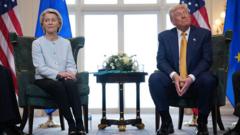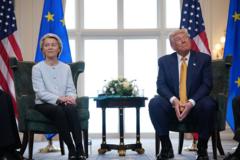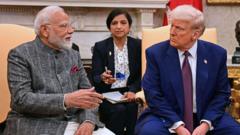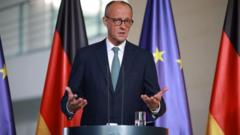Despite the announcement of a new EU-US trade agreement aimed at reducing tariffs, European officials have voiced their concerns about unresolved details and the potential burden on specific nations, particularly Germany, Ireland, and Italy, as negotiations continue.
Ongoing EU-US Trade Negotiations Faces Criticism and Uncertainties

Ongoing EU-US Trade Negotiations Faces Criticism and Uncertainties
European leaders express discontent with the recently announced trade deal with the US, highlighting ongoing discrepancies and potential negative impacts on certain EU countries.
The recent announcement of a trade agreement between the European Union and the United States has been met with skepticism from several European leaders who believe that the deal, which aims to reduce tariffs, still leaves many critical aspects unresolved. Although the tense negotiations resulted in avoiding a steep 30% tariff previously threatened by US President Donald Trump, many argue that the newly established 15% tariff on most EU exports to the US places undue strain on certain EU countries.
European Commission chief Ursula von der Leyen and Trump were seen smiling and shaking hands during the deal's announcement; however, European nations are recognizing that the actual terms lack firmness and clarity. While the new tariff rate is an improvement over previous threats, it still represents a significant increase from the former average of 4.8%.
Germany’s finance minister, Lars Klingbeil, acknowledged the completion of the deal as delivering some much-needed certainty, yet he lamented that he had hoped for a stronger negotiating position. On the other hand, the Commission made it clear that this agreement will not be legally binding, featuring only political commitments.
French President Emmanuel Macron remarked on the deal being a preliminary step, emphasizing that ongoing discussions are critical to establish final terms. Experts suggest that these negotiations could take a year or more, leaving industry participants in a state of limited assurance.
Under the umbrella of this new accord, the US and the EU appear to be interpreting terms differently. The US reported that industries such as pharmaceuticals and semiconductors would be subject to the 15% tariffs; however, EU officials indicated that these sectors would remain at 0% until new global rates are agreed upon.
The landscape is starkly divided; Germany, Ireland, and Italy are poised as the countries facing the largest burdens from this trade deal. For Germany’s automotive industry, a crucial part of its economy, the US accounts for a significant 13% of exports worth about €34 billion. Similarly, Ireland's economy is heavily dependent on the US market, particularly in pharmaceutical exports.
Italy is bracing for a 0.2% GDP contraction due to the tariffs impacting its key industries, propelling some trade associations to demand compensation from the EU. The Italian Confederation of Farmers even lamented that the agreement seemed more of a concession than a win for Europe.
As discussions continue, experts warn that blanket compensation demands from EU exporters could translate to higher costs for taxpayers, essentially allowing the Trump administration's tariffs to financially burden European citizens. Looking ahead, it remains clear that the ongoing negotiations will be critical, as European leaders seek to balance commitments with their own national interests.


















